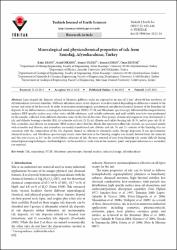| dc.description.abstract | Lens-shaped talc deposits related to Mesozoic gabbroic rocks are exposed in an area of 2 km
, about 80 km northwest of
Afyonkarahisar (western Anatolia). Different alteration zones in talc deposits were determined depending on differences related to the
texture and color of the host rock. In order to determine mineralogical, geochemical, and physicochemical features of the Emirdağ talc
deposits, X-ray diffractometer, scanning electron microscope (SEM), FT-IR and Mössbauer spectroscopy, differential thermogravimetric
analyses, BET-specific surface area, color, water soluble substance, acid–soluble carbonate, and acid–soluble iron tests were performed
on the samples collected from different alteration zones in the lateral direction. Four groups of mineral paragenesis were determined: i)
talc and chlorite-bearing actinolite (E1), ii) actinolite-rich talc (E-2), iii) chlorite and calcite-bearing talc (E-3), and iv) pure talc (E-4).
Talc, actinolite, and chlorite are dominant. SEM analyses show that fine shreds, like microcrystalline talc crystals, are associated mainly
with actinolite and chlorite, and actinolites are mainly transformed into chlorite and talc. Ni and Cr contents of the Emirdağ talcs are
consistent with the composition of the talc deposits formed in relation to ultramafic rocks. Energy dispersive X-ray spectrometry,
chemical analysis, and Mössbauer spectroscopy results show that iron in the Emirdağ samples was mainly derived from talc minerals
and this iron occurs as Fe
+2
2
in the crystal lattice structure of talc. Because removal of iron from Emirdağ talc seems difficult during
mineral processing techniques, the Emirdağ talc can be used in its crude state in the cosmetic, paint, and paper industries as a secondary
raw material. | en_US |



















